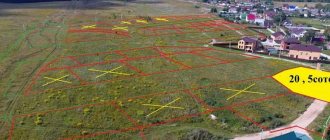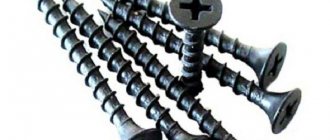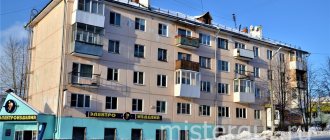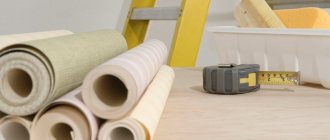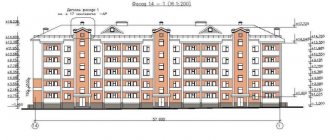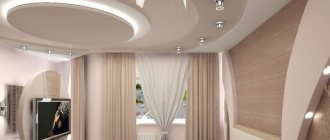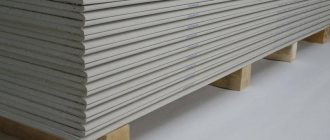Repair is an activity that can cost quite a decent amount. Although our website talks about drywall, even such a relatively economical material, both in terms of funds and in terms of consumption per square meter, can cost, although not a small, but not a small amount. In the articles we talk about how and where you can save money during the repair process, and where you shouldn’t do this, as you can significantly lose in the quality of the product.
Another tip that will help you save some of the funds set aside for repairs is to create the correct calculation for the consumption of metal profiles that are used to create the frame of the product, which is covered with sheets of plasterboard. Calculations will help you decide on the number of profiles needed, which will allow you to avoid buying an extra profile “just in case there isn’t enough.”
But let us immediately warn you that calculation is always a rather difficult task, and calculating profiles for drywall is sometimes even more difficult than creating a frame from this profile. Therefore, for complex calculations of both rack and guide profiles, it is better to use a calculator, which can be found on similar resources. It will allow you to carry out calculations much faster, easier and more accurately; you only need to provide the original data. Please note that the standard profile length is 3 meters; this figure must be taken into account when making calculations. Also, the dimensions of the drywall sheet are 1200x3000 millimeters. You need to know this in order to carry out the calculations correctly, because all measurements will be carried out based on the dimensions of one sheet of drywall.
GKL sheet - what is it? Dimensions and thickness, types of material
One of the irreplaceable and popular materials in construction and repair is plasterboard.
It is used both for the construction of various structures, such as partitions or multi-level ceilings, and for cladding the internal and sometimes even external surfaces of premises. This distribution is due to the attractive characteristics of gypsum boards: light weight, relatively low price, sufficient strength and ease of processing. Construction stores offer a huge selection of different types, brands and manufacturers of plasterboard sheets and gypsum boards. It can be difficult to make a choice in this variety right away. In order not to make a mistake, you need to clearly understand what type of plasterboard sheets are used for various construction works and on what basis you can choose high-quality plasterboard. Let's try to understand these issues.
Theory
Drywall calculation
We determine the area of the wall (ceiling) and divide it by the area of the selected standard size of plasterboard sheet. The resulting result is rounded up. If we are talking about a partition, then we double the number of sheets (since there is drywall on both sides), and then round up to the nearest whole.
Profile calculation
Calculation of the number of hangers and connectors
The calculation of the number of hangers (straight hanger) is calculated as follows: 4 hangers per 1 m² of structure. The number of crab connectors is calculated as follows: approximately 2.4 crabs per 1 m² of structure.
They are usually not used for the construction of partitions.
Calculation of hardware
Self-tapping screws for drywall
The number of screws for attaching drywall to a frame made of profiles is determined as follows:
Self-tapping screws for profiles
Determined based on the number of profiles, hangers and connectors:
Dowel-nails
Dowel nails are used to secure the guide profile to the concrete surface (one every 50 cm) and to attach direct hangers (two for each).
Source
What is drywall
Plasterboard sheets are a solid panel of gypsum material, which is covered on both sides with thick cardboard. At first glance, it may seem that gypsum is too fragile a material to be used in construction. It is the cardboard that adds strength to gypsum boards, thanks to which the sheets do not break, chip or crumble. At the same time, they are very easy to process: sawing, bending and even planing. And special additives give different types of plasterboard sheets very different properties.
Despite the strength, for the construction of various structures from gypsum plasterboard it is necessary to use a frame base that ensures uniform distribution of the load on the entire structure and increases its strength.
The photo clearly demonstrates the structure of a plasterboard sheet.
Subtleties of moving and storage
Drywall is a rather fragile material and can be easily damaged. In order to avoid unnecessary costs, it is enough to follow a number of simple rules and recommendations:
- This material can only be stored horizontally on a completely flat base. This rule also applies to transportation. Any pebble or bolt that falls under a stack of drywall sheets will ruin at least one of them. The material will simply break or crumble under its own weight.
- Two people carry the gypsum board in an upright position. If you carry it flat, it will break, unable to withstand the vibration.
- As a rule, they carry the sheet by picking it up with one hand from below, and holding it with the other and preventing it from swinging. But this is quite inconvenient, and problems arise when passing through doorways. Therefore, professional movers use special devices in the form of a kind of hook. They seem to “lengthen” the arm, which makes carrying much more comfortable.
- During transportation and storage, it is necessary to protect the material from moisture.
Where are plasterboard sheets used?
Plasterboard sheets are used in construction to solve a variety of problems:
- For finishing (leveling) walls and creating interior partitions. Wall gypsum board has a thickness of 12.5 mm, a length of 2.3 or 2.5 meters, and a width of 1.2 meters. The properties of such sheets are standard; no special additives are provided in their design. Color grey, with blue markings.
- For the ceiling. With the help of gypsum boards, you can not only cover the ceiling under a tension structure, but also create a multi-level plasterboard ceiling or niches for hidden lighting. For these purposes, sheets of different sizes are used: the thickness of the ceiling plasterboard is 9.5 mm, the length is 2 or 2.5 meters, and the width remains the same. The properties are also standard, the color and markings are the same as for the wall one.
- For covering rooms with high humidity (often used in conjunction with additional waterproofing). For these purposes, a special type of drywall is used - moisture-resistant (GKLV). The GKLV core contains special additives, and even the cardboard itself is impregnated with antifungal compounds. The length of its sheets is 2.3 or 2.5 meters, thickness - 12.5 mm, standard width - 1.2 meters. Such sheets are painted green, the markings are blue.
- For lining chimneys, fireplaces and rooms with high fire safety requirements. Despite the fact that cardboard in any type of gypsum board does not burn, but only chars, gypsum boards additionally contain a large amount of reinforcing fibers and additives in the core, due to which the middle part of the sheets does not deform during a fire. Such sheets have a standard width and thickness, their length is 2, 2.5 or 3 meters, they are painted light pink with red markings.
- For creating arches and other curved structures. Despite the fact that ordinary wall plasterboard can be bent in several ways, for these purposes it is better to use flexible arched plasterboard sheets. Their core contains fiberglass threads, which generally strengthen the material. Thanks to its small thickness of 6.5 mm, this drywall is easy to bend and give it any curved shape. Its width is standard, length is 3 meters, color is light gray.
The following photo shows the process of creating an arch from plasterboard sheets.
The scope of application of plasterboard is so wide that it can explain the popularity of this building material for interior decoration.
Rules for installing drywall that will be useful to us
The required number of hardware is calculated based on the design of the frame, the type of future finishing and other factors. There are a few rules you need to know about.
About self-tapping screws
First, let's decide on the type of screws. The gypsum plasterboard is attached to the metal and wooden frames with different hardware, which differ from each other in the cutting step.
Regardless of the type, they are screwed into the body of the drywall with a slight recess so that the caps do not protrude above the surface. And from the edge of the sheet an indent of 1 cm is made.
Screw in the self-tapping screw correctly, departing from the edge of the sheet about 10 mm
About the frame
Now about the frame itself, because it is on it that the sheets are installed. For calculations, we will take a standard sheet measuring 120x250 cm. The dimensions may be different, but the essence does not change.
The number of main longitudinal profiles depends on the width of the gypsum board ; these values must be multiples. The instructions recommend making the following distances between the racks:
- 60 cm - for the installation of wall cladding, installation of partitions and other simple vertical structures intended for painting or wallpapering;
- 40 cm - for cladding ceilings, creating multi-level structures. And also for walls finished with tiles or stone.
Frame diagram for a room no more than 2.5 meters high
Such steps between the racks allow adjacent panels to be joined on one profile and the fasteners are evenly distributed.
If the height of the room is greater than the length of the plasterboard sheet , jumpers are placed between the longitudinal profiles at the level of the junction of two adjacent cladding elements.
With ceilings it is more difficult: to securely fix the gypsum board, the frame is made longitudinally and transversely over the entire area. The cell side size can be 40x40, 60x60 or 40x60 cm.
Frame for ceiling cladding
Since drywall is attached to each element of the frame, it is clear that the more profiles per unit area, the more hardware will be required.
But the rate of consumption also depends on the pitch between the attachment points. And it may also differ depending on the type of surface being finished.
There are no strict rules on this matter, but there are the following recommendations:
- The step should not be less than 10 cm , otherwise the gypsum core will crumble.
- The optimal distance between screws when attaching a sheet to a vertical surface is 25–35 cm . Subject to “light finishing. If it is a tile, it is reduced to 15–20 cm.
- The distance between the screws when attaching drywall to the ceiling is 10–20 cm . It depends on its thickness and weight. The greater the thickness, the more often the fastening.
The fixation of the ceiling sheets must be reliable, so the fasteners are screwed in more often
- If the cladding is done with a double layer of plasterboard, the first layer can be fastened rarely, leaving 40–60 cm between hardware. And it’s not a matter of saving - the price of fasteners is not so high as to save on reliability. Just by fixing the second layer with longer hardware, you will also fix the first one.
Installation diagram of two-layer cladding
Do not forget that the frequency of fastening may vary due to the complex configuration of the structure. For example, when installing niches or multi-level ceilings, both vertical and horizontal sections and various bends are fixed.
If the width of the element is less than 12 cm, the screws are screwed in in a checkerboard pattern.
Calculation example
For example, let’s take the cladding of a wall 3 m high and 4 m long. Since the length of the plasterboard is 2.5 m, in addition to the vertical posts, we will need to mount horizontal connecting jumpers with our own hands at a distance of 50 cm from the floor or ceiling.
It is advisable to alternate their position for each subsequent sheet, as shown in the diagram.
Frame diagram for calculating the number of screws
The conditions for calculation are as follows:
- The pitch between the posts is 40 cm.
- Each sheet has 4 racks 250 cm long and 6 horizontal sections 40 cm long.
- Select the pitch of the screws to be 25 cm.
We count:
- 250: 25 + 1 = 11 pieces per rack;
- 11 x 4 = 44 pieces for all racks;
- 44 + 6 = 50 pieces in total for each sheet.
Let me explain: at the top and bottom between the racks it is enough to install one hardware each, since 40 is a bit too much, and more often there is no point.
But in the diagram we only have three whole sheets and five smaller inserts. In order not to shortchange each one, let’s calculate the consumption of self-tapping screws per 1 m2 of drywall. For what:
- Divide the resulting quantity by the sheet area: 50: 3 = 17 pieces;
- The total area of the wall to be finished is 12 square meters. m. This means that in total we need: 12 x 17 = 204 pieces;
- Any materials need to be purchased with a margin of 10–15%, so to be sure, it is better to take 220–230 pieces.
It is clear that with a different frame installation scheme and a different fastening step, the result will be different.
Frame diagram for cladding a wall with a window
In this diagram, the racks for the outer sheets are installed in increments of 60 cm, and for the middle part - 40 cm. The consumption of hardware for their fastening will be different.
I don't think it needs to be calculated exactly. In addition, self-tapping screws are usually sold not by piece, but by weight. Buy with a reserve - this product does not deteriorate and can always come in handy.
Classification of plasterboard sheets according to GOST
GCR can be classified in two ways:
- according to GOST 6266-97;
- in accordance with GOST 32614-2012.
The differences between these two standards are primarily in the time of their adoption. GOST from 1997 divides drywall into 4 main types:
- Ordinary plasterboard sheets (GKL).
- Moisture-resistant plasterboard sheets (GKLV).
- Fire-resistant drywall (GKLO).
- Combining the properties of fire resistance and moisture resistance, plasterboard (GKLVO).
The following photo shows how the main types of drywall differ in color.
GOST, published in 2012, was developed jointly with Knauf. According to it, plasterboard is now called gypsum building boards and is divided into eight types:
- Type A, which is a standard gypsum board.
- H – moisture-resistant boards (the same as gypsum boards).
- F – fire-resistant gypsum boards (or GKLO).
- D – slabs with different densities depending on their operating conditions.
- I – especially hard gypsum boards.
- E - slabs used for facade work and having the properties of minimal water absorption and vapor permeability (GKLV with improved characteristics).
- P – slabs on which it is intended to apply plaster mixtures or lay tiles.
- R is a building material that allows you to create fairly strong bends in any direction.
Nowadays, almost all drywall on the construction market is produced under the Knauf brand. These are the same gypsum building boards. GKL from Knauf has better characteristics compared to other manufacturers, however, the price of material from more well-known brands may be higher. The following photo shows one of the types of gypsum building boards of the Knauf brand.
What does the weight of 1 m 2 gypsum board depend on?
The obvious parameters of gypsum board that affect the weight of the sheet are its length, width and thickness. Therefore, let’s skip them and consider what else can affect the mass. To do this, you need to know what this building material is made of. Essentially, hardened plaster with functional additives was wrapped in construction paper. Here's how the mass is distributed in the sheet itself:
- 90-94% of the mass is gypsum;
- 4-6% of the mass is cardboard;
- 1-2% of the mass comes from various additives (PVA, starch, etc.);
The weight of drywall varies depending on the proportions of the above components. The composition varies depending on the type of gypsum board. Conventional, moisture-resistant and fire-resistant gypsum boards use gypsum with various additives to enhance their characteristics. Therefore, gypsum boards, gypsum boards and gypsum boards will have different weights, despite the same parameters of length, width and thickness.
Humidity greatly affects how much 1 sheet of drywall weighs. The drier the room, the less the weight of the sheet. The higher the humidity, the more gypsum absorbs it, increasing its mass.
It is recommended to let the drywall rest in the room where the repair is being carried out before work. Its humidity will be equal to the humidity in the room and during operation it will not dry out or increase in volume. It is better for the plasterboard to dry or moisten before it goes into work.
Now the logical question arises, how can you determine the weight of drywall, if this parameter is influenced by so many factors, some of which may change over time (humidity). For this purpose, there is GOST 6266-97, which specifies how the weight of a given building material is determined. This is done as follows.
- The gypsum board is placed in a drying chamber, where it remains for 24 hours at a temperature of 40-42 degrees.
- The mass of the sheet is measured, and then it is returned to the chamber for at least another two hours.
- The previous procedure is repeated until the mass deviation between the current and previous values is less than 0.1%.
- The last result is the mass of the sheet.
- Dividing the mass by the product of the length and width of the sheet, we get the weight of drywall per 1 m2.
Standard sizes, weight and strength of drywall
Gypsum plasterboards have the following dimensions:
- The length can vary among different manufacturers from 1.5 to 3.6 meters. The most common values are 2, 2.5 and 3 meters.
- The standard width is 1.2 meters, but smaller products with a width of only 0.6 meters can also be found on sale. This parameter greatly simplifies the transportation of this building material and reduces its weight.
- The thickness varies between 6–12.5 mm. Most often, the thickness of drywall depends on its purpose. For example, a minimum thickness is required to create arches and other curved structures, while thicker sheets are used to build walls. In addition, you can also find particularly durable slabs, the thickness of which is 25 mm.
When purchasing plasterboard, it is worth remembering that there are two different categories of this material - A and B. In the first case, the dimensions of the sheet deviate from the standards set by GOST by no more than a couple of millimeters. In the second, even the squareness parameter may have deviations. And although most manufacturers do not indicate the category at all, since they produce plasterboard of category A, this factor is worth taking into account.
The weight of drywall is significantly lower compared to other building materials. Moreover, this applies to any type and size of gypsum board - the additives present in the material slightly increase its weight. Even a plasterboard wall reinforced with a metal frame will be much lighter than, for example, a brick wall.
One millimeter of sheet thickness is one kilogram per square meter, this is how the nominal weight of gypsum boards is calculated.
The strength of a product depends on its purpose, as well as on the quality of the materials used in its manufacture. Since the choice of both cardboard and gypsum composition is not regulated in any way and manufacturers can easily choose the composition of gypsum boards themselves, the quality of cheap brands can be significantly lower than global manufacturers, such as the above-mentioned Knauf.
Formulas and calculation procedure
Let us immediately explain that the guide profile (UD) is used to create the basis of the future frame; only after its installation can the rack profile be used. The guide profile is attached to the wall, and the rack profile is attached to it. The rack profile, in turn, is used to create a platform on which the drywall will be attached; it is located between the guide profile. Also, it should be noted that we will not describe the process of complex calculations, since this does not make sense, because now there are many special programs that can cope with this task much more efficiently than a person, even an experienced specialist.
So, to calculate the number of profiles you will need for your product, you need to measure the size of the surface on which you are going to create the frame. Once the dimensions are known, you can begin to calculate the number of profiles. To do this, we will use formulas that are not the only ones, you can find others, but we advise you to use them, since they were tested by many specialists, after which they had no complaints about accuracy. Also, we note that it is advisable to use these formulas for sheets of drywall of standard sizes, otherwise difficulties may arise with its installation on the frame.
To find out the required number of UD profile slats, you must use this formula. The height and length of the wall are added together, after which the result is multiplied by 2. Then this amount is multiplied by a correction factor, which is 1.2. The resulting number must be divided by the length of the profile, that is, by 300 centimeters. So, as a result, you will receive a number that will indicate the required number of UD profile slats.
To calculate CD profiles, a slightly different formula is used. You need the number that means the length of the room, divided by 60 centimeters, and then multiplied by the correction factor, which is still 1.2. Also, it is important to note that all numbers that you receive as a result of calculations must be rounded up, so you will also have enough profile for some unforeseen cases. For example, it will be possible to use small pieces of the profile to strengthen the frame.
If you have read other articles on our website, then you probably know that in addition to profiles, the frame also uses hangers, the number of which will also need to be calculated. For it, the number, which indicates the number of all CD profiles, is multiplied by 5, since this is exactly how many hangers are needed for one profile rail, the length of which is 3 meters.
In general, that's all. Of course, these formulas are not ideal; with their help it is impossible to calculate and take into account all the features in the frame, but they are very universal. If you need to find out the number of profiles in a more complex frame, then, as stated above, seek help from programs that can be found on almost every construction site. We have described the basic principles that will help beginners in calculating the profile, both for a plasterboard ceiling and for a wall. But they are not designed for complex and intricate designs, in which there are many bends.
How much does a sheet of drywall weigh?
Which is better: heated floors or radiators?
Warm floorBatteries
Drywall today is very popular as a construction and finishing material. It is convenient to use, durable, practical, and easy to install. Our article is devoted to the features and characteristics of this material, and, in particular, its weight.
Peculiarities
Drywall (its other name is “dry gypsum plaster”) is a necessary material for the construction of partitions, sheathing and other purposes. Regardless of the sheet manufacturing company, manufacturers try to adhere to general production principles. One sheet consists of two sheets of construction paper (cardboard) and a core consisting of gypsum with various fillers. Fillers allow you to change the properties of drywall: some allow it to be resistant to moisture, others enhance sound insulation, and still others give the product fireproof properties.
Initially, plasterboard was used only for leveling walls - this was its intended purpose; now it is increasingly used as a structural material.
Characteristics
The standard sheet width is 120 cm or, if we convert this to mm, 1200.
Standard sizes provided by manufacturers:
- 3000x1200 mm;
- 2500x1200 mm;
- 2000x1200 mm.
Drywall has a number of advantages:
- Eco-friendly material - does not contain harmful impurities.
- High fire resistance (even with ordinary drywall).
- Easy installation - no need to hire a special team.
Main characteristics of drywall:
- Specific gravity in the range from 1200 to 1500 kg/m3.
- Thermal conductivity is within 0.21-0.32 W/ (m*K).
- Strength with a thickness of up to 10 mm varies around 12-15 kg.
For high-quality repairs, it is preferable to have an idea not only of the options for using drywall, but also of its characteristics.
In construction it differs:
- GKL. The usual type of plasterboard is used to create interior walls, suspended ceilings and structures of different levels, partitions, design elements and niches. A distinctive feature is the gray color of the top and bottom layers of cardboard.
- GKLV. Moisture resistant sheet. Used in the bathroom or kitchen, on window slopes. The moisture-resistant effect is achieved through modifiers in the gypsum core. Has a green cardboard color.
- GKLO. Fire resistant material. It is necessary for installing ventilation or air ducts when covering fireplaces, building facades, and in boiler rooms. Provides increased fire protection. Contains fire retardants in the core. It has a red or pinkish color.
- GKLVO. A sheet that combines moisture and fire resistance. This type is used when finishing baths or saunas. May have a yellowish color.
Why know the weight?
When doing DIY repairs, few people think about the weight of building materials. The sheet of drywall is solid, has a certain size, and if the building does not have a freight elevator, the question arises of how to lift it to the desired floor, bring it into the apartment and, in general, move it. This also includes the method of transporting materials: whether the trunk of your car can accommodate the required number of sheets, and whether the car can withstand the weight stated by its carrying capacity. The next question will be to determine the number of people who can handle this physical work.
For large-scale repairs or redevelopment, a larger amount of materials is needed, therefore, transportation costs will already be calculated, since the carrying capacity of transport is limited.
Knowing the weight of the sheet is also necessary to calculate the optimal load on the frame to which the cladding will be attached or the number of fasteners. For example, if you calculate how much a plasterboard ceiling structure weighs, it becomes clear why you should not neglect determining the weight. Weight also indicates the possibility or impossibility of bending the sheet to make arches and other decorative elements - the smaller the weight, the easier it is to bend it.
State regulations
Construction is a responsible business, so there is a special GOST 6266-97 that determines the weight of each type of plasterboard sheet. According to GOST, an ordinary sheet should have a specific gravity of no more than 1.0 kg per 1 m2 for each millimeter of thickness; for moisture-resistant and fire-resistant products, the range varies from 0.8 to 1.06 kg.
The weight of drywall is directly proportional to its type: it is customary to distinguish between wall, ceiling and arched sheets; their thickness will be 6.5 mm, 9.5 mm, 12.5 mm, respectively.
Calculation of the number of sheets for the ceiling
- the length, width and area of the ceiling are determined. To determine the area, multiply the length by the width;
- the number of sheets is calculated: the area of the ceiling is divided by the area of one sheet;
- a correction factor is selected that affects the amount of waste. This coefficient depends on the area of the ceiling. For an area of up to 10 m2, the coefficient is assumed to be 1.3. If the area is from 10 to 20 m2, the coefficient is taken from 1.2 to 1.15. For large areas, over 20 m2, the coefficient ranges from 1.1 to 1.05;
- the number of sheets is specified. To do this, the previously obtained quantity is multiplied by the selected coefficient. The result is rounded to the nearest whole number (up).
Prices for drywall
Gypsum plasterboard is one of the most sought after and popular building materials for the installation of walls and ceilings. All this is easily explained by the fact that plasterboard is a universal material, smooth and strong enough to withstand vertical loads. One sheet of plasterboard occupies an area of three square meters, so calculating how much plasterboard costs one square meter is not difficult, from 50 to 100 rubles. Therefore, it is fair to assume that the prices for plasterboard as a universal finishing material are quite acceptable, given that such a material as plasterboard is quite convenient during installation, as well as preparing the sheet for installation.
Many people believe that prices for drywall are quite high, although this is absolutely not the case. If we take an analysis of the building materials market as a whole, then when asked how much plasterboard costs, an average figure of 200-350 rubles per sheet will appear, depending on whether it is ordinary plasterboard, waterproof or fire-resistant. Many people ask how much plasterboard costs on the market, believing that prices for plasterboard are lower in construction markets. In fact, this is not entirely fair, since many large hardware stores constantly hold promotions, during which the question “how much does drywall cost” disappears by itself, since prices for drywall are reduced by an order of magnitude. Also, prices for drywall depend on the manufacturer, for example, domestic drywall will be several tens of rubles per sheet cheaper than imported one.
And finally, answering the question of how much plasterboard costs, we can say that, of course, in online stores prices for plasterboard are significantly lower, in addition, they offer a comfortable delivery service directly to the construction site, which will greatly facilitate your transportation task.
Instructions for online drywall calculator
To calculate drywall for a wall, partition or ceiling, first fill in the dimensions in millimeters:
Y – The height of the partition or wall (length of the ceiling) that needs to be sheathed.
X – Width of a wall, partition or ceiling.
Y and X values depend on the size of your room and the design solution; they can be easily measured with a construction tape.
H – Sheet length. Standard length of plasterboard sheet according to GOST 6266-97 “Gypsum plasterboard sheets. Technical specifications" is 2500 mm. This material can also be produced in lengths from 1500 to 4000 mm.
Z – Sheet width. According to the standard, the value of Z = 1200 mm, however, depending on the manufacturer, the width of the plasterboard can be from 600 to 1500 mm. Be sure to check the dimensions of the plasterboard sheets with the supplier before purchasing.
S – The number of rack profiles per sheet of plasterboard is selected based on the width of the facing material. It is optimal to place rack profiles every 600 mm (it is possible to reduce the pitch to 300-400 mm if increased load-bearing capacity of the structure is required). S value should be selected between 2 and 4.
V – Number of layers of drywall. For a wall, sheathing with one layer of plasterboard is usually sufficient. If additional strengthening, leveling and sound insulation are required, which is important for arranging partitions, more layers may be needed (optimally no more than two). Increasing the number of cladding layers significantly reduces the size of the room and increases material consumption.
The calculator's capabilities allow you to select a V from one to four.
B – The distance between the screws for attaching the plasterboard sheet to the profile is taken from 100 to 250 mm.
N1 – Primer consumption rate for treating 1 m2 of surface. The primer consumption must be indicated by the manufacturer of the product on the packaging, and you can easily find it there. However, these are average cost rates. Actual consumption will depend on the type of surface being primed, the time of year and weather conditions, and the method of applying the primer. Therefore, you should make a reserve of up to 10% above the consumption declared by the manufacturer.
Drywall sheets (GKL): what are the sheet sizes, types and correct calculation per 1 m2
It should be borne in mind that plasterboard sheets are available in several types and each is suitable only for use in certain conditions: A standard sheet has an area of 3 square meters. meters. By manually measuring the walls, you need to calculate their area and subtract the area of windows and doors from the total area. Then the resulting number (if necessary) is rounded up and divided by the area of the standard sheet.
The weight of a standard sheet of drywall (width 1.2, thickness 1.25, length 2.5 meters) is on average 29 kilograms (if it was stored in a dry room). GCR is capable of absorbing moisture, so the actual weight may be greater than that declared by the manufacturers. For covering a balcony with plasterboard (side height 1.5 meters), small sheets 1.5 meters long and 0.6 meters wide are ideal.
Or a standard-width plasterboard sheet three meters long, cut in half. Plasterboard sheets are one of the most convenient and environmentally friendly materials. They are installed quickly, look aesthetically pleasing and require almost no preliminary rough work.
Before you go shopping, it is important to know the types and sizes of plasterboard sheets.
Profile calculation
The basic rule that must be followed is that mounting should occur either vertically or horizontally. You cannot use two methods at the same time. For convenience, it is better to use the vertical method.
Calculating the guide profile
Wall perimeter P = (a + b + c + d) *2 . We multiply by two, because the guides need to be fixed to the ceiling. The result obtained must be divided by the length of one profile (standard - 3 m.p.) and we obtain the quantity of the required guide profile. The resulting number is rounded up.
Let's calculate the number of guides using the previous example. The perimeter of the room is 6 + 4 + 6 + 4 = 20 m. Divide by three = 6.6. Round up and multiply by two. We will need 14 three-meter guides.
Rack profile calculation
The length of the walls must be divided into spaces between the rack profiles - 0.4 or 0.6 m.p. at a height of three meters. We already know the length of our walls, it is twenty meters. We divide this value by 0.6 and get - 33.33. Rounding up, for our room we need to purchase 34 m of profile. Divide 34 by 3m profile length, we get 11.33. Round up - 12 pcs.
The profiles are fastened to the wall using hangers, in increments of 60 centimeters. Accordingly, a three-meter aluminum profile will require five fasteners. And at twelve, sixty.
How much does a square meter of drywall cost?
Its versatility and ease of installation have long established plasterboard as the most versatile building material. The cost of one square meter of drywall depends on the structure, thickness and area of its application. To calculate how much one square meter of drywall costs, let’s take the cost of a regular gypsum board with standard sheet dimensions of 2500x1200 and a thickness of 9.5. The area of such a sheet is 3 square meters.
GKL (Gypsum Cardboard Sheet) is a material based on gypsum, and the outer sides are lined with cardboard (special construction paper). The areas of application are limited only by your or designer's imagination. In turn, gypsum board has several types, focused on different areas of application.
GVL (gypsum fiber sheet) is an environmentally friendly material. It is produced by semi-dry pressing of a mixture of gypsum binder and fluffed cellulose waste paper. Possessing high strength, hardness, as well as high fire-technical characteristics, it is widely used in floor repairs, namely in dry screed technology.
GKLO (Gypsum Cardboard Sheet O fire-resistant) is a material in the core of which special additives are also added. You can distinguish gypsum board from ordinary gypsum board by a special red marker. GKLO is an ideal building material for applications where there is a high risk of fire or increased air temperature.
There is an opinion that GKLO is capable of withstanding 20 minutes of direct fire exposure.
GKL sheet - what is it? Dimensions and thickness, types of material
The differences between these two standards are primarily in the time of their adoption. GOST from 1997 divides plasterboard into 4 main types: Despite its strength, for the construction of various structures from gypsum plasterboard it is necessary to use a frame base that ensures uniform distribution of the load on the entire structure and increases its strength.
- Ordinary plasterboard sheets (GKL).
- Moisture-resistant plasterboard sheets (GKLV).
- Fire-resistant drywall (GKLO).
- Combining the properties of fire resistance and moisture resistance, plasterboard (GKLVO).
Construction stores offer a huge selection of different types, brands and manufacturers of plasterboard sheets and gypsum boards. It can be difficult to make a choice in this variety right away. In order not to make a mistake, you need to clearly understand what type of plasterboard sheets are used for various construction works and on what basis you can choose high-quality plasterboard. Let's try to understand these issues.
Plasterboard sheets are a solid panel of gypsum material, which is covered on both sides with thick cardboard. At first glance, it may seem that gypsum is too fragile a material to be used in construction. It is the cardboard that adds strength to gypsum boards, thanks to which the sheets do not break, chip or crumble.
At the same time, they are very easy to process: sawing, bending and even planing. And special additives give different types of plasterboard sheets very different properties.
Screws and dowels
The total number of these elements is also easy to calculate. The UD profile is attached to the wall at intervals of 0.4 meters. To fix the suspension to the ceiling, 2 screws are required. In the case of a solid reinforced concrete floor, one is enough. Thus, we simply count the number of attachment points and get the required number of dowels and screws.
Calculation of drywall, watch the video:
Conclusion
Now you know how to calculate drywall for the ceiling and, as it turns out, it’s not at all difficult. All you need is a little patience and spatial imagination. If it is difficult for you to mentally imagine how the profiles and sheets will be located, then make a rough sketch. This way, you can compare two options for installing profiles and choose the one that is more suitable for your case.
Having learned to calculate the design of a single-level ceiling, you can begin to develop more complex systems. So, you can create a curved two-level ceiling structure, with hidden lighting along its perimeter. We wish you success in your repairs and hope that our portal will become reliable assistants in your endeavors.
Drywall: price per sheet, sizes and types of material
Knauf products are manufactured by a German company that has proven itself in the construction market. Let's consider the main advantages of this brand: For walls, you can use thicker plasterboard, but for the ceiling, 9.5 mm sheets are usually used in order to reduce the weight of the ceiling structure . Please note! The weight of a 12.5 mm plasterboard sheet is indicated for a reason.
Such sheets are in greatest demand among buyers. Fire-resistant sheets are used in rooms where the humidity level may be low or normal. In this case, the cardboard can be either pink or red. Gypsum plasterboard fireproof sheets are marked in red.
The standard length of gypsum boards is 2.5 m, and the width is 1.2 m. Also, the following sizes can be classified as standard lengths: 3 and 3.5 m. In addition to standard sizes, in markets and in hardware stores you can find plasterboard sheets, the length of which maybe 4 m. Sometimes there are sheets with a length of 1.2 m (small-sized). The sizes and prices of drywall are interrelated. For example, sheets whose thickness is 9.5 mm are cheaper than twelve-millimeter products.
How to treat the surface → Room decoration → How to choose the right paint → Surface treatment technologies → Leveling and finishing the walls → Selecting and applying a primer → Removal from the surface → Stretch ceilings and technologies → Reviews and testimonials
How to cover walls with plasterboard
To begin work, you need to prepare equipment. You can start covering with plasterboard only if you have the following tools:
There are two ways to install gypsum boards:
Let's consider both options.
Installation of drywall on the frame
Before attaching the drywall, a frame base is created. If necessary, wires or other communications can be hidden under the sheets. For construction, we will need guides 27*28 and a mounting profile 60*27.
Installing drywall with glue
Before starting installation, you need to make sure that the surface is even. For this, a long rule and level are used. Having measured the vertical, horizon and diagonal, we note all the irregularities and differences. For wall cladding, it is necessary to use gypsum board with a thickness of 12.5 mm.
Apply the adhesive to the plasterboard sheets using a comb spatula with a tooth size of 10 - 12 mm. And if the deviations of the wall are more than 12 mm, in these places it is necessary to apply glue in “bumps”.
In more detail, you can see all the intricacies of installation in this video:
Calculation of drywall for a partition - consumption rates, calculator
Ceiling plasterboard calculator
How to calculate the area of a room: formulas, tips and tricks
How to calculate paint consumption for walls and ceilings?
Grout consumption for tiles per 1 m2 - calculator, calculation formula
How to calculate wallpaper rolls, accurate calculation calculator
Source
